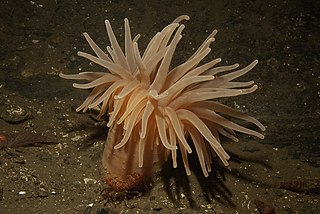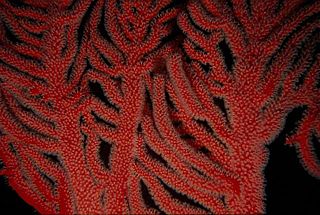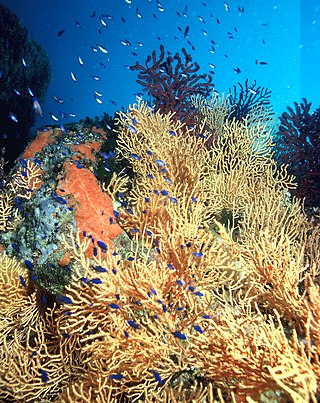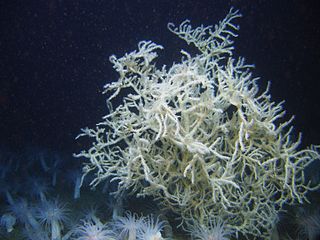
Anthozoa is a class of marine invertebrates which includes the sea anemones, stony corals and soft corals. Adult anthozoans are almost all attached to the seabed, while their larvae can disperse as part of the plankton. The basic unit of the adult is the polyp; this consists of a cylindrical column topped by a disc with a central mouth surrounded by tentacles. Sea anemones are mostly solitary, but the majority of corals are colonial, being formed by the budding of new polyps from an original, founding individual. Colonies are strengthened by calcium carbonate and other materials and take various massive, plate-like, bushy or leafy forms.

Bolocera tuediae, commonly known as the deeplet sea anemone, is a sea anemone found in the sublittoral zone of the North Sea. It was first discovered near Bewick, England by Johnston in 1832. It is distinguished by its large, hexamerous size and shedding of tentacles. The nematocysts of the anemone can have dangerous effects, including the rupturing of human blood cells. The deeplet sea anemone was observed to have a symbiotic relationship with shrimp, as they cluster around its base in both temperate and Northwest Atlantic waters.

Simnia spelta is a species of sea snail, a marine gastropod mollusc in the family Ovulidae, the ovulids, which are cowrie allies sometimes called "false cowries". It was first described in 1758 by the Swedish naturalist Carl Linnaeus.

The multicoloured sea fan is a species of gorgonian sea fan in the family Melithaeidae.

Obelia longissima is a colonial species of hydrozoan in the order Leptomedusae. Its hydroid form grows as feathery stems resembling seaweed from a basal stolon. It is found in many temperate and cold seas world-wide but is absent from the tropics.

The nippled sea fan, is a species of gorgonian sea fan in the family Gorgoniidae.

The sinuous sea fan is a species of gorgonian sea fan in the family Gorgoniidae.

The palmate sea fan is a species of gorgonian sea fan in the family Gorgoniidae.
Swiftia pallida is a species of gorgonian-type octocoral in the family Plexauridae sometimes known as the northern sea fan. At one time it was considered to be a subspecies of Swiftia rosea.
Swiftia rosea is a species of gorgonian-type octocoral in the family Plexauridae.
Amphianthus dohrnii, the sea fan anemone, is a species of sea anemone in the family Hormathiidae. It occurs in the northeastern Atlantic Ocean and Mediterranean Sea and grows on sea fans.

Paramuricea clavata, the violescent sea-whip, is a species of colonial soft coral in the family Plexauridae. It is found in shallow seas of the north-eastern Atlantic Ocean and the north-western Mediterranean Sea as well as Ionian Sea. This species was first described by the French naturalist Antoine Risso in 1826.

Eunicella cavolini, commonly known as the yellow gorgonian or yellow sea whip, is a species of colonial soft coral in the family Gorgoniidae. It is native to parts of the eastern Atlantic Ocean, Mediterranean Sea and Ionian Sea where it is a common species.

Leptogorgia sarmentosa is a species of colonial soft coral, a sea fan in the family Gorgoniidae. It is native to the eastern Atlantic Ocean and the western Mediterranean Sea, with a single find in the eastern Mediterranean.

Alcyonium coralloides, commonly known as false coral, is a colonial species of soft coral in the family Alcyoniidae. It is native to the northeastern Atlantic Ocean and the Mediterranean Sea. In the former location it generally grows as sheets or small lobes but in the latter it is parasitic and overgrows sea fans.

Eunicella singularis, the white gorgonian, is a species of colonial soft coral, a sea fan in the family Gorgoniidae. It is found in the western Mediterranean Sea, Adriatic Sea and Ionian Sea. It was first described in 1791 by the German naturalist Eugenius Johann Christoph Esper.

Astroides is a genus of stony cup corals in the family Dendrophylliidae. It is monotypic and the only species is Astroides calycularis, which is endemic to the western Mediterranean Sea. The species was first described in 1766 by the German naturalist Peter Simon Pallas.

Savalia savaglia, commonly known as gold coral, is a species of colonial false black coral in the family Parazoanthidae. It is native to the northeastern Atlantic Ocean and the Mediterranean Sea where it often grows in association with a gorgonian. It is extremely long-lived, with a lifespan of 2,700 years, and develops into a large tree-like colony.

Leiopathes glaberrima is a species of black coral of the order Antipatharia found in the northern Atlantic Ocean and the Mediterranean Seas deep water habitats. A very slow-growing species, it is among the oldest living animals on the planet.

















